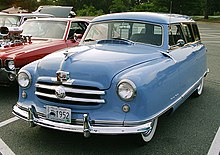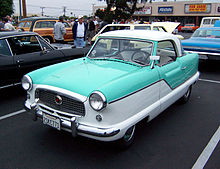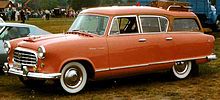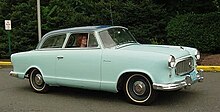Nash Airflyte
The Nash Airflyte was Nash Motors' first attempt in Kenosha , Wisconsin to produce a streamlined passenger car . At the same time, it is the car manufacturer's first redesign after the Second World War . According to Nils Wahlberg's theories , an aerodynamic pontoon body was developed in the wind tunnel. It had round shapes and integrated front fenders and was significantly wider and lower than the bodies of the cars produced up to then. Even the wheel cutouts were missing, so as not to give the passing air an edge for turbulence.
First series, 1949–1951
The Nash 600 was the first model to be fitted with this hatchback body from 1949 . Compared to the previous year's model, the new car offered much more space and had a front window without a central bar. All four doors were hinged at the front. The larger Ambassador also got the new body. Due to their round shape, which was clearly reminiscent of an inverted bathtub, the vehicles were also popularly known as the Nash Bathtub .
In 1950 the Type 600 was renamed Statesman . In addition, the Nash Rambler was a new, compact model that only had two doors and smaller engines. The company's president, George Mason , figured that this would mean better market opportunities overall. In the following year, a 3-door station wagon called Greenbrier was added.
Second series, 1952–1954
In 1952, the Airflyte concept was revised: the radiator grille became larger, the entire body more angular and at the end of the first, small tail fins grew. The panoramic rear window , which some Rambler models already had in 1951, was also adopted for the larger cars. They had also forfeited their hatchbacks in favor of a more classic notchback shape. In view of the company's 50th anniversary (if you include the years of the predecessor Thomas B. Jeffrey Company ), the new cars were marketed as Golden Airflytes .
In 1954, the Nash Metropolitan was the first true American small car to appear with a comparable styling . Its Airflyte body came from an American pen, while the mechanics came from Austin from Great Britain . The car was also built in Great Britain and imported into the USA.
Third series, 1955–1960
In 1955 and 1956, the appearance of the Airflyte models was changed again. The most noticeable change was the new wheel cutouts in the front fenders, and later also in the rear. The complete covering of the wheels in the earlier versions reduced the air resistance, but also hindered the turning of the wheels, so that the Airflyte models had a significantly larger turning circle than all other car models of their time.
As early as 1954, the merger with Hudson Motor Car Co. resulted in the new American Motors Corporation , which initially continued to manufacture cars under the Nash and Hudson brand names. The last Hudson models also benefited from the Airflyte styling. The first Rambler American from 1958 still had echoes of the (modernized) Airflyte styling before these round shapes went completely out of fashion in the early 1960s.
swell
- Martinez, Alberto and Nory, Jean Loup: From Cadillac to Studebaker - The American dream cars of the fifties , 1st edition, Motorbuch Verlag, Stuttgart (1982), ISBN 3-87943-885-4
- Gunnell, John (Editor): The Standard Catalog of American Cars 1946-1975. , 4th edition, Krause Publications, Iola (WI) (2002), ISBN 0-87349-461-X







